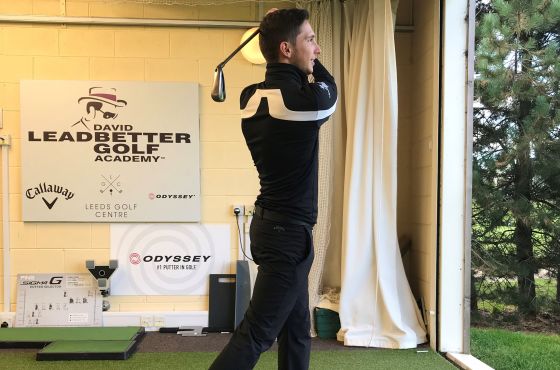Pro tips for beginner golfers: posture and pivot

The fundamentals are easily forgotten when you’re eager to get out on the course – our pro golfers see it all the time. But just spending a little time mastering your posture will make your pivot more effective, and improve the speed and power of your swing.
Persuaded to put in some practice? Here’s some sound advice from our PGA professional, Jack, for you to follow next time you’re at the driving range.
Posture
1. Make sure to build a stable base by placing your feet a shoulder width apart for a mid iron.
2. Your weight should be evenly distributed over the bottom lace of your shoe or the balls of your feet. This should place you in a ‘ready’ position.
3. Bow your upper body over, at about a 45 degree angle, leaving your arms hanging down. This is will allow for a good hip hinge. You might find it handy to use a golf club to help you get into this position. Hold the club horizontally to help form the hinge and let your arms relax. Now take your grip from here.
4. Now bend your knees just slightly so that your new position is in an athletic posture ready for your golf swing.
Common problems to watch out for
Jack often sees this (below) incorrect posture where the weight, bow and bend are out of kilter. If your posture looks like this, return to step one.
Pivot
The pivot in your golf swing is the rotation of your body and transfer of weight, which forms your backswing and downswing. The backswing pivot should feel like a small transfer of weight from your centre, to the inside of your right foot and heel, making sure that your upper body stays behind the left side and ready to load into the downswing.
Two techniques for a perfect backswing pivot
• The pot of gold
It’s as simple as imagining that you’re reaching across to pick up a pot of golf at your right. This will create the desired motion for your backswing. If you’re left handed, you’ll need to reach to your left.
• The club across chest movement
Position two golf balls with one adjacent to each of your feet, a shoulder width apart. Place your club across your chest and fold your arms over the club. Assume your golf posture and then turn right and left, pointing your club towards each ball as you go. Note the movement in your upper body and apply this to your backswing in future.
The downswing pivot
Once you’ve nailed your backswing, you’re ready to sequence your downswing. The downswing should start with the ground and your feet, your weight transferring across from your left side to your right, into an explosive position. Your arms and club should then follow, ‘firing’ last in the sequence.
Your downswing should feel a bit like throwing a javelin where your left side would start the sequence of motion, followed last by the upper body, arms and javelin (or your golf club!).
We’re sure that Jack’s top tips will help to up your game. Just remember: posture is king. And if you’d like to take your learning further then why not check out our tuition packages here